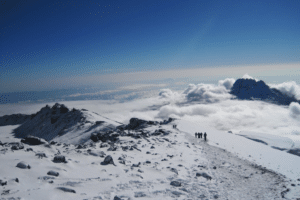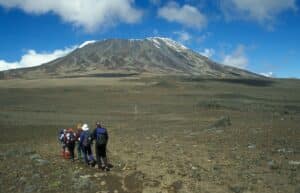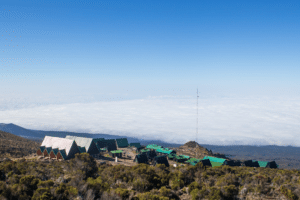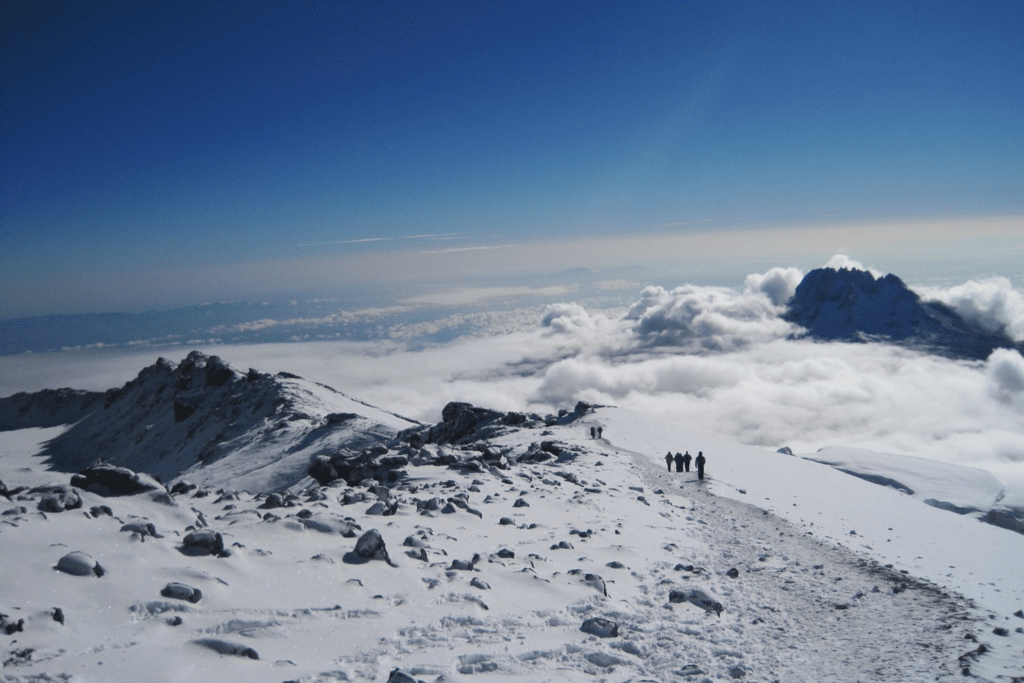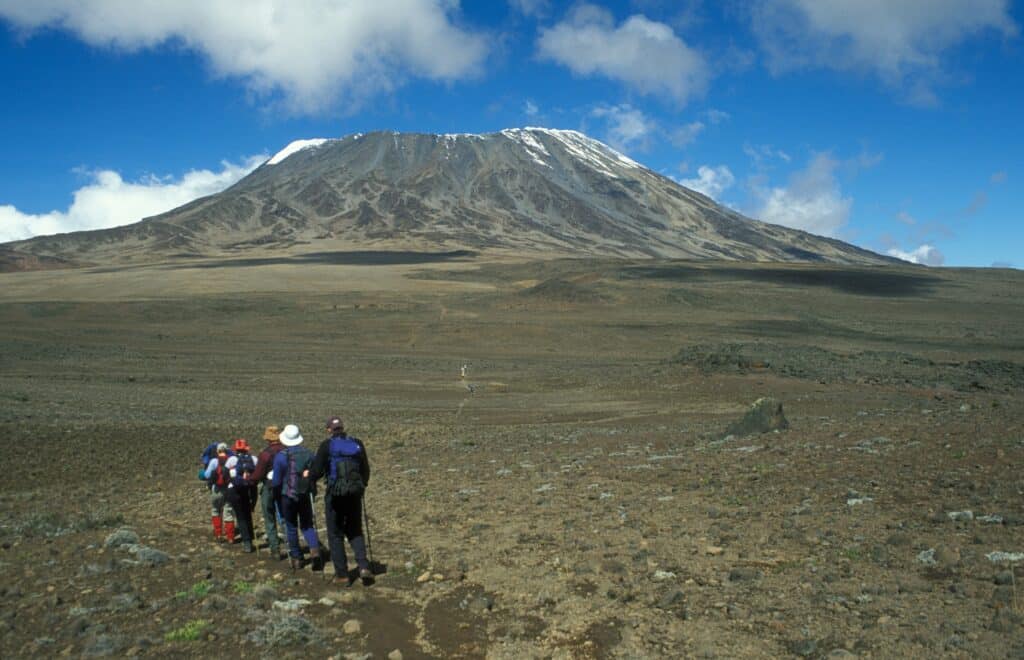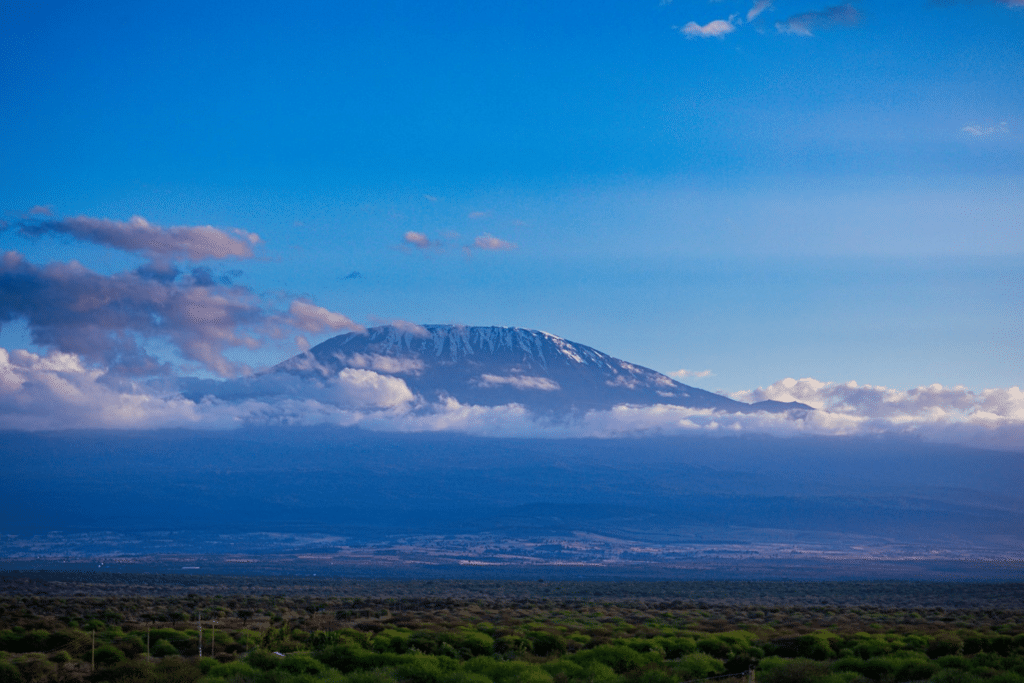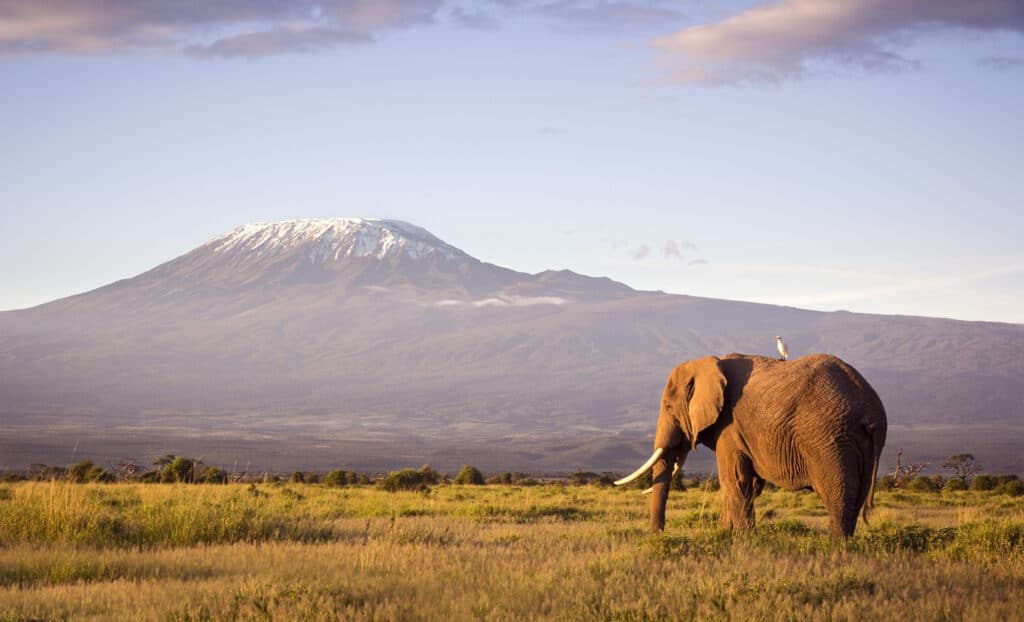Are you excited about what animals you can see during your Mount Kilimanjaro climb? If so, we’ve got you covered!
So, what animals will I see while climbing Mount Kilimanjaro? You’ll encounter the serval cat, Jackson’s chameleon, Colobus monkey, and many more!
In this article, we’ll guide you through these animals and more. But first, let’s discuss how broad Mount Kilimanjaro National Park is.
Mount Kilimanjaro National Park encompasses 1,688 square kilometres or 652 square miles. It was a forest reserve in 1921 and became a National Park in 1973.
Then, in 1987, it became a UNESCO World Heritage Site due to its rare natural beauty and unique endangered animals and plant species. So, what animals can you see on Kilimanjaro? Let’s find out!
Jackson's chameleon
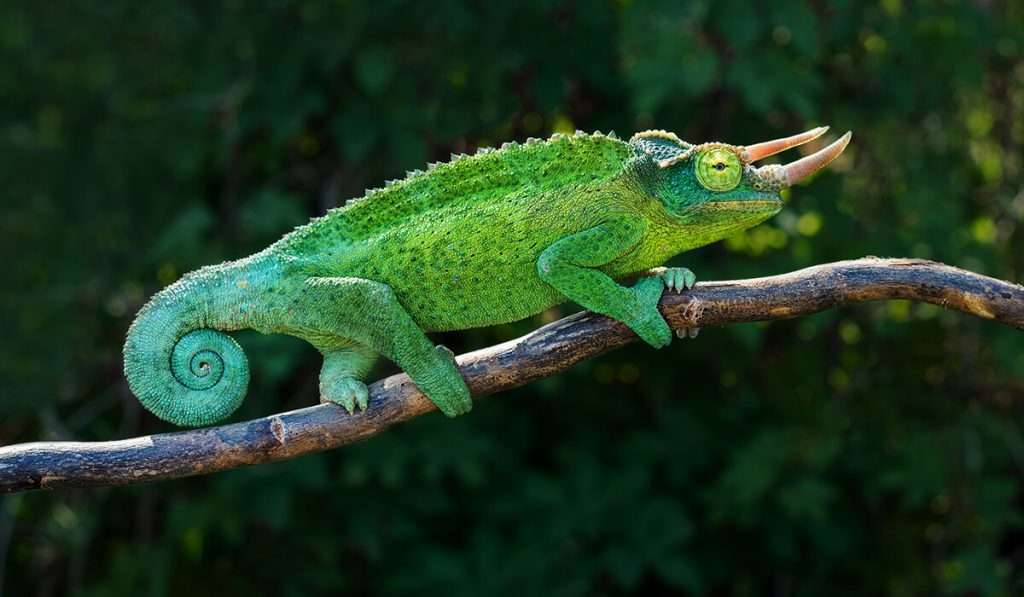
The Jackson Chameleon is native to the forests and woodlands of northern Tanzania. It lives at an altitude of 1,600 to 2,440 metres (5,250 to 8,010 ft). The chameleon changes its colour and adapts to its environment to protect itself against predators.
Typically, they change their colour based on emotions, temperature and light. Their eyes can move separately, allowing them to see two different directions simultaneously.
These chameleons possess specialized vision and the ability to eject their tongues to a range twice the length of their bodies, which is how they capture and eat insects.
It’s been noted that a three-horned chameleon in Kilimanjaro is known as the Jackson chameleon. In addition, there’s the Dwarf Fischer’s chameleon—a smaller version of the Jackson chameleon with only two horns.
Colobus monkey

Colobus monkeys is one of the animals on Mount Kilimanjaro that can be viewed in the Kilimanjaro trailheads and the rainforest part of the mountain. They have pretty black fur, whiskers, a long white mantle, a beard around their face and a bushy two-foot-long tail.
They have black and white colours and are distinguishable by their U-shape white hair flowing from their shoulders to their lower back. Colobus monkeys are born white and transition to black and white in adulthood.
Bush baby

Bush babies, or Galagos, are some of the smallest primates on Mount Kilimanjaro. They are the same size as squirrels. Their mournful cries and cute appearance may account for their name, “bush baby.”
They possess large, round eyes with a bat-like good night vision. Their ears are sensitive, allowing them to track their insect prey in the dark. When they sleep or jump at the thorn bush, they fold their ears flat into their heads to shield them.
These creatures are nocturnal and have brownish-grey to light-brown coats. They’re agile and can jump from tree to tree. Their diet includes moths, grasshoppers, tree gums, and fruits.
Groups of thick-tailed bush babies are hefty and everywhere within Kilimanjaro National Park. They’re typically found throughout Eastern Africa and can survive in local areas. Their habitat is savanna grasslands, woodlands, and forest borders extending across the equatorial belt of Africa.
White-necked raven

The white-necked raven is an endemic species of Southern and Eastern Africa. It can grow to 19 to 21 inches long and weigh 1.6 to 1.9 pounds.
They get their names from the large white patch feathers on their necks. They also possess deep bills with white tips; their whole bodies are black.
They often distance themselves from humans and are typically found in mountainous areas like Mount Kilimanjaro. They feed on the rotting flesh of animals, insects, and small lizards.
They also feed on vegetables, seeds, and grains. You can surely see these large birds flapping their wings at the campsite, waiting for the opportunity to get food. Thus, leaving your daypack alone is not advisable, as these ravens are bold enough to crash into it and get your snacks.
Blue monkey

Despite its name, the blue monkey doesn’t appear to be blue. It has short hair on its face that gives it a blue look, but it is never a vivid blue colour, like the mandrill.
This animal on Mount Kilimanjaro has more of an olive or grey colour—aside from the face, which is dark with some yellowish patch on the forehead. Their size ranges from 50 cm to 65 cm in length and can weigh up to 8 kg for males and 4 kg for females.
You can see these monkeys around Kilimanjaro’s rainforest, particularly at Big Forest Camp, the first campsite on the Lemosho Route.
Serval cat

Serval cats are medium-sized, slender cats that can grow to 62 cm long and weigh up to 40 pounds. They have large ears with small heads and are golden-yellow with black spots and stripes.
This cat has slightly the same look as the cheetah in terms of colours but is more petite and much more slender in form. They also possess long legs and are good runners.
They live alone and are active during the day and night. They prey on small rodents but eat almost anything, from wild rabbits to reptiles, insects, and grass.
Duiker
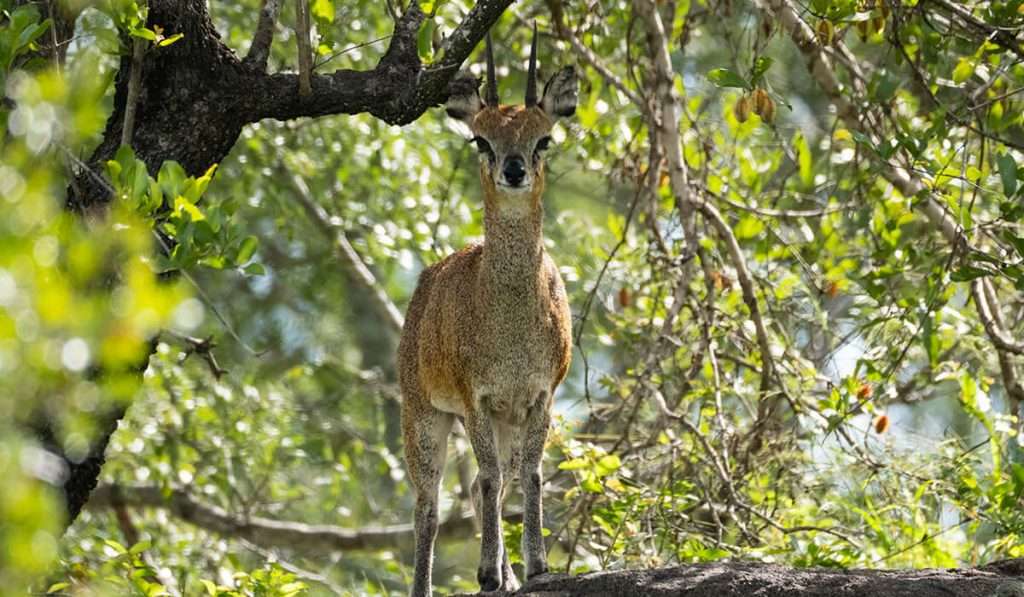
Duiker is an antelope species that is much smaller than the grassland antelope. They typically live in heavily wooded areas so you won’t see them on the usual safari through the savannah.
However, don’t let this dishearten you. You have a higher chance of seeing them in their natural habitat on the slopes of Kilimanjaro.
Marsh mongoose
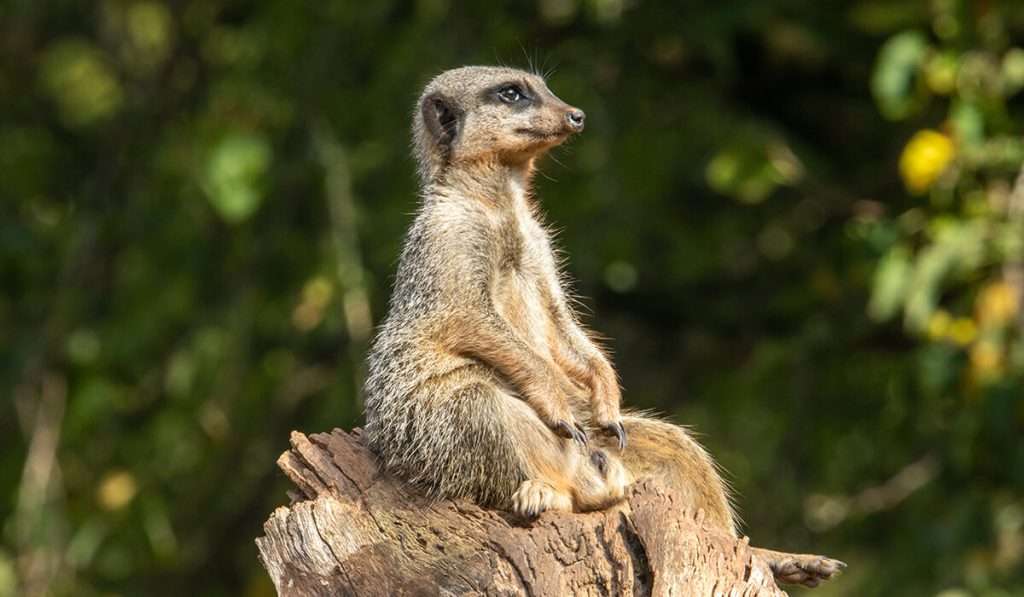
The Marsh Mongoose is from the same mongoose family. The only difference is that it’s aquatic compared to its white-tailed sibling.
These animals like to swim in swampy areas and pretend to be sunbathing when it’s hunting for birds! The pinkish skin in their fur attracts birds to check them out closer.
Once they’re close enough, the Marsh Mongoose swiftly catches the bird and has its dinner. You’ll likely see these animals on the smoother trails of Kilimanjaro.
Come and see the mount Kilimanjaro animals for yourself!
Mount Kilimanjaro is broad, and you might encounter many other animal species (not on this list). If you want to see the animals listed in this article and more, come and see them for yourself as you conquer the tallest freestanding mountain in the world, Kilimanjaro!
If you’re interested in climbing Mount Kilimanjaro, seeing its wildlife and experiencing the feeling of reaching its peak, book a tour today!
Frequently Asked Questions (FAQs)
Are there any animals on Mount Kilimanjaro?
Mount Kilimanjaro is home to various animals, including blue monkeys, tree hyraxes, and bird species. While climbing the mountain, trekkers may encounter these animals in their natural habitats, specifically in the lush tropical rainforests surrounding it.
What types of animals can be found in the surrounding rainforest?
In the lush rainforests surrounding Mount Kilimanjaro, a vibrant ecosystem thrives, bustling with many wildlife species. Among the dense vegetation, climbers may encounter blue monkeys swinging through the trees, tree hyraxes perched on rocky outcrops, and elusive honey badgers foraging for food.
These diverse rainforest inhabitants contribute to the mountain’s ecological richness and offer trekkers a captivating glimpse into the natural world as they ascend the slopes. Amidst the verdant foliage, each sighting presents a unique option to connect with the untamed beauty of Kilimanjaro’s surrounding wilderness.
Are there any endangered species on Mount Kilimanjaro?
Nestled within Mount Kilimanjaro’s diverse ecosystems, endangered species such as the tree hyrax and the four-striped mouse find refuge. These creatures play crucial roles in maintaining the delicate balance of the mountain’s ecosystem, contributing to its biodiversity and resilience.
As stewards of the natural world, efforts are made to protect these vulnerable species within the confines of the national park, safeguarding their habitats and ensuring their continued survival. Amidst the awe-inspiring landscapes of Kilimanjaro, encountering these elusive and precious creatures serves as a poignant reminder of the importance of preservation in keeping Earth’s biological diversity.
What are some examples of nocturnal animals found on Mount Kilimanjaro?
In the darkness of Mount Kilimanjaro’s night, nocturnal creatures such as tree hyraxes, four-striped mice, and various bat species come to life. Adapted to the rhythms of darkness, they navigate their surroundings with remarkable agility, often evading detection during the daytime.
As the sun sets, these elusive creatures emerge from their hidden abodes, venturing forth to forage and explore. While their sightings may be rare, encountering these nocturnal denizens adds a layer of intrigue and mystery to the Kilimanjaro trekking experience, offering glimpses into the hidden world that thrives under the cover of night.
Do venomous snakes inhabit Mount Kilimanjaro?
Within the diverse habitats of Mount Kilimanjaro lurk several species of venomous snakes, including the formidable puff adders and spitting cobras. Although encounters with these reptiles are infrequent, climbers should exercise caution when traversing the mountain’s terrain.
While the snakes typically avoid human contact, their presence underscores the importance of remaining vigilant and respecting the natural environment. By staying alert and sticking to established trails, climbers can minimize the risk of encountering these elusive serpents during their ascent.
What types of monkey species can be found on Mount Kilimanjaro?
The lush forests of Mount Kilimanjaro are home to a variety of monkey species, such as blue monkeys and colobus monkeys, which are known for their remarkable agility and social behaviours. Observing these primates in their natural habitat adds an exciting dimension to the trekking experience, as they can often be seen swinging gracefully through the trees or foraging for food on the forest floor.
With their distinctive calls echoing through the canopy, encountering these curious creatures offers climbers a memorable glimpse into the vibrant ecosystem of Kilimanjaro’s forests. As climbers ascend through the mountain’s distinct vegetation zones, they may have the opportunity to observe these fascinating monkey species thriving in their mountainous habitat.
How do animals on Mount Kilimanjaro interact with human food?
Animals on Mount Kilimanjaro, including various monkey species and nocturnal creatures, may be attracted to human food left unattended or improperly stored by climbers. To mitigate the risk of wildlife encounters, climbers should adhere to park regulations and ensure food wastes are correctly disposed of in designated areas.
This helps maintain a safe environment for climbers and wildlife, reducing the likelihood of conflicts between humans and animals during the trek. Additionally, storing food securely in sealed containers or hanging it out of reach of animals can further prevent unwanted interactions and uphold the ecological balance of the mountain’s ecosystem.
Are there any solitary animals on Mount Kilimanjaro?
Some animals on Mount Kilimanjaro, like honey badgers, are inherently solitary. They often forage alone rather than in groups. Renowned for their resilience and adaptability to diverse environments, these creatures independently navigate the mountain’s terrain.
Their solitary behaviour enables them to efficiently locate food sources and prevent competition with other animals in their habitat. As elusive beings, encountering honey badgers during a Kilimanjaro trek is a rare but remarkable experience, showcasing the mountain’s rich biodiversity.
How do animal habitats change as climbers ascend Mount Kilimanjaro?
As climbers make their way up Mount Kilimanjaro, they traverse through four distinct vegetation zones, each harbouring unique animal habitats. Beginning with lush tropical rainforests at lower elevations, climbers may encounter species like blue monkeys and tree hyraxes amidst the dense foliage.
As they ascend, the landscape transitions into moorland and alpine deserts, where animals like four-striped mice and solitary honey badgers are adapted to survive in harsh conditions. Finally, near the summit, climbers reach the barren alpine desert zone, where only the hardiest of creatures, like rock hyraxes and various bird species, can be found amidst the sparse vegetation.
What role do wild animals play in the ecosystem of Mount Kilimanjaro?
Wild animals on Mount Kilimanjaro maintain the ecosystem’s balance by controlling prey species’ populations, dispersing seeds, and contributing to nutrient cycling. Their presence enriches the mountain’s biodiversity and enhances the overall trekking experience for climbers.
Encounters with these animals provide unique opportunities for observation and appreciation of the natural world, adding depth to the climbing experience. As climbers traverse through different habitats, they may witness various species adapted to their specific niches, highlighting the interconnectedness of life on the mountain.
How does climbing Kilimanjaro impact the surrounding wildlife?
While climbing Kilimanjaro, trekkers may inadvertently disturb wildlife’s natural habitat, temporarily disrupting their behaviour patterns. However, park regulations and responsible trekking practices help minimize the impact of human activity on the surrounding wildlife.
By staying on designated trails, avoiding loud noises, and respecting wildlife’s space, climbers can coexist harmoniously with the mountain’s animals. Additionally, trekking guides provide valuable insights into wildlife behaviour and conservation efforts, fostering a deeper appreciation for the natural environment.
What precautions should climbers take to avoid encountering wild animals on Mount Kilimanjaro?
Climbers must comply with park regulations, which include correctly storing food and refraining from feeding or approaching wild animals. It’s crucial to stay vigilant and refrain from solo hiking, especially during early morning or late evening when nocturnal creatures are most active.
Respecting wildlife’s space and observing them from a safe distance is essential to prevent conflicts and safeguard both climbers and the natural habitat of Mount Kilimanjaro’s wildlife. Adhering to these guidelines ensures climbers’ safety and minimizes any adverse effects on the mountain’s ecosystem.
Have any unique animal sightings been reported during the Kilimanjaro treks?
Climbers on Kilimanjaro treks have reported unique animal sightings, including rare species such as the tree hyrax and the four-striped mouse. These sightings add to the adventure and excitement of trekking through the mountain’s diverse habitats. Observing these elusive creatures in their habitat provides climbers with memorable experiences and enriches their understanding of the mountain’s ecosystem.
How do animals adapt to the challenging conditions of Mount Kilimanjaro?
Animals on Mount Kilimanjaro have evolved adaptations to survive in the mountain’s harsh environments, including thick fur coats for insulation, specialized diets, and nocturnal behaviour to avoid extreme temperatures. These adaptations enable them to thrive in their habitats and contribute to the mountain’s ecological diversity. Through these remarkable adaptations, wildlife on Kilimanjaro showcases nature’s resilience and ability to adapt to challenging conditions, offering climbers a glimpse into the intricacies of mountain ecology.
What measures are in place to protect the wildlife of Mount Kilimanjaro?
Mount Kilimanjaro is located within a protected national park, where strict regulations are enforced to preserve the natural habitat and wildlife. Park rangers monitor animal populations, enforce wildlife protection laws, and educate climbers on responsible trekking practices to ensure the continued conservation of the mountain’s biodiversity. These efforts aim to balance between promoting sustainable tourism and safeguarding the delicate ecosystem of Mount Kilimanjaro for future generations to enjoy.
What precautions should I take to avoid encountering wild animals while climbing Mount Kilimanjaro?
Climbers should follow park regulations and guidelines concerning wildlife encounters. These entail storing food appropriately and refraining from feeding or approaching wild animals. It is paramount to ensure a safe distance from wildlife and prevent any actions that may provoke or startle them.
When hiking, travelling in groups and producing noise along the trail, it is advisable to alert animals to your presence, reducing the chances of unexpected encounters. Additionally, climbers must remain vigilant and attentive to their surroundings, mainly where wildlife sightings are common.
Implementing these precautions dramatically reduces the risk of potentially hazardous wildlife encounters during the climb.
Are there specific areas on Mount Kilimanjaro where I’m more likely to spot wildlife?
While wildlife can be encountered throughout the various vegetation zones of Mount Kilimanjaro, certain areas are known for higher concentrations of animal activity. The lush tropical rainforests at lower altitudes are prime habitats for blue monkeys, colobus monkeys, and tree hyraxes.
Climbers are more likely to spot wildlife near water sources or along forested trails where animals forage for food. As climbers ascend to higher elevations, they may encounter nocturnal animals such as tree hyraxes and four-striped mice in rocky outcrops or crevices.
Being observant and patient while hiking through these areas increases the chances of spotting wildlife.
How do animals on Mount Kilimanjaro adapt to the changing seasons and environmental conditions?
Animals on Mount Kilimanjaro have evolved various adaptations to cope with the mountain’s fluctuating environmental conditions. During the dry season, animals may migrate to lower elevations to look for food and water.
Species such as the tree hyrax and four-striped mice are nocturnal, allowing them to avoid the day’s intense heat and conserve energy. Additionally, animals may adjust their behaviour patterns in response to seasonal changes in vegetation and prey availability. These adaptations enable wildlife to thrive in the diverse habitats of Mount Kilimanjaro throughout the year.















